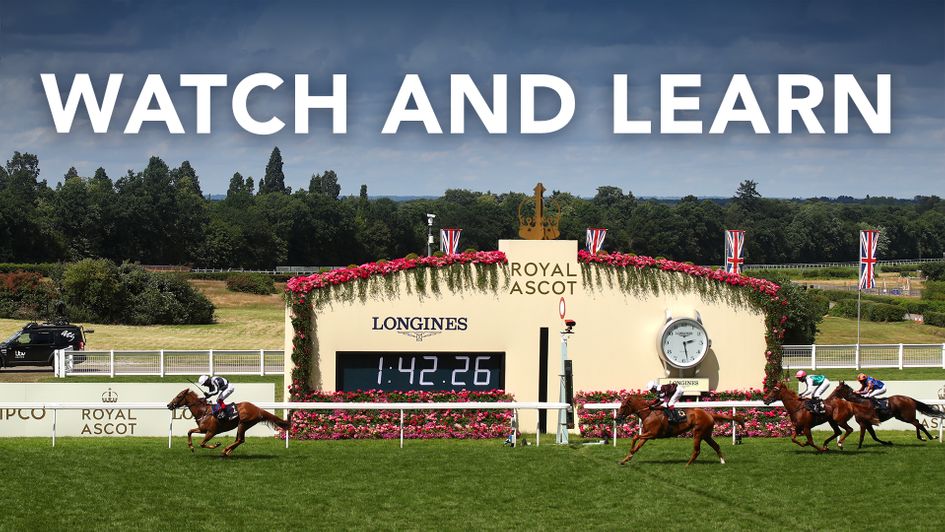
Watch & Learn: Timefigure analysis from Graeme North on Adayar and the two-year-old scene
Following his victory in the King George VI and Queen Elizabeth Qipco Stakes last weekend, Adayar is officially now the highest rated horse in Britain (he’s rated 127 by the BHA and 131 by Timeform who have him narrowly ahead of St Mark’s Basilica).
Surprisingly the first three-year-old to win the Derby and the King George in the same year since the mighty Galileo in 2001, Adayar was full value for his win and is a better horse than the clock has so far shown him to be, having recorded timefigures of 121 at both Epsom and Ascot after sectional upgrades have been incorporated.
For all that Adayar was advantaged positionally at Ascot – the configuration of the track and the gradients ensure that the order entering the home straight is effectively decided climbing out of Swinley Bottom – in what only became a truly-run race once the slow-starting Broome had made his way to the front after two furlongs, he was well on top come the line and left the impression that a thorough end-to-end gallop will soon see him post a timefigure more commensurate with his ability.
The sectional timing data provided by Longines freely accessible on Ascot’s website shows that Adayar ran the fastest final furlong (12.05, Love next best with 12.17) in the King George as well as the fastest penultimate furlong (11.51, Mishriff next with 11.63) and covered 6 metres (roughly 2 lengths) further than Love (though ground loss is very context dependent and isn’t equal across individual portions of the race) while hitting a top speed of 41.4 mph compared to Mishriff’s 40.7 and Love’s 40.9.
By dint of coming from further back, Mishriff earns a slightly bigger upgrade than Adayar but not enough to think he was in any way unlucky and it’s not difficult to imagine Adayar, once he learns to settle, extending his winning margin over Mishriff should the pair meet again.
For what it’s worth, Galileo never won again after the King George, finishing second in the Irish Champion Stakes before an audacious tilt at the Breeders’ Cup Classic, but Adayar looks set to take a more conventional path and deserves his place at the head of the Arc betting.
Talking of markets, now we are getting into the teeth of the summer, those for next year’s 1000 Guineas and 2000 Guineas are starting to firm up and there were a couple of notable performances last week that impacted both.
The first was in the Listed Star Stakes at Sandown, after which it surprised me more to learn I had so many Madchester-aware followers on my social media timeline than she had leapfrogged to the head of the Guineas betting.
The 2020 renewal of the Star was a strong running – the winner Fev Rover went on to finish third in the 1000 - but this year’s renewal looks much a fair bit better still. Neither a timefigure of 86 nor a 2lb upgrade (admittedly the best of the principals, albeit taken from 4f out which isn’t especially helpful) shouts Guineas winner on day where the ordinary handicapper Arenas Del Tiempo ran easily the best relative time, but Inspiral ran four of the last five individual furlongs faster than any of her rivals, including a seriously impressive third-last furlong where she wasn’t far off dipping under 11 seconds while half of her rivals were running 12 or more.
A daughter of Frankel out of a mare who stayed a mile and a quarter, Inspiral is certainly an exciting prospect and will be well suited by a mile. So too will Point Lonsdale, who cemented his place at the head of the 2000 market after retaining his unbeaten record in the Listed Tyros Stakes at Leopardstown later the same evening.
The Tyros has been something of an Aidan O’Brien benefit in recent years, winning the previous seven running's including with the likes of Classic winners Gleneagles, Churchill and Anthony Van Dyke, and Point Lonsdale might not be far off that trajectory himself.
Backed as if defeat was out of the question, he was always travelling comfortably and barely had to exert himself to pass the line three lengths clear in a 102 timefigure. That’s 7lb less than the 109 he achieved at Ascot which remains the second-best juvenile timefigure this season behind Go Bears Go (111).
One youngster who won’t shine at a mile but is worth keeping onside at sprint trips is Johnny Murtagh’s rapidly improving filly Ladies Church.
Fourth on her debut at Cork, Ladies Church has won both her subsequent starts dropped to the minimum trip, following up a narrow win at Tipperary with a much more convincing victory last week in the inaugural running of the Listed Marwell Stakes at Naas.
A 104 timefigure for that effort (the camerawork on the day and the track layout were unhelpful in obtaining sectionals) puts her among the best of her sex and generation, and the turn of foot she showed to bolt clear over a furlong out should stand her in good stead in Group races.
She already looks to have achieved more than Princess Margaret winner Zain Claudette whose bunched-finish Ascot win, while giving some credence to the form of the Super Sprint at Newbury, was worth only 90 on the clock.
Anyone who follows me on Twitter (@jumpspacemaps) might well be familiar with the pace maps I often share when the jumps season is full swing. What these show, for those unfamiliar with them, is how the pace for any particular race on the card (except for bumpers) varied within the race compared to the overall time from the first obstacle timed, which is usually the first in the shortest race in each particular discipline (so if the shortest hurdle race was at two miles, timings for all the races over hurdles would be taken from the first hurdle in the two-mile race).
The resulting pace figures aren’t timefigures per se, as computing a deadly accurate set of inter-race timefigures over jumps isn’t really feasible in view of the limited amount of data that exists (though it could be done relatively easily at somewhere like Kempton or Lingfield on the Flat where there is a wealth of sectional data) but they are still useful as they can unpick races where the form is much stronger or much weaker than the result on paper might suggest far better than overall timefigures can.
There was a good example of this at Stratford the Sunday before last where two of the three chases were won by Hatcher and Royal Ruby. I should mention firstly that the additional yardage posted on the BHA website by the Stratford executive on the day was totally nonsensical, and hopefully if one of them is reading this they will go back and correct the incorrect information, but for the our purposes that shortcoming isn’t relevant as we are comparing times between, and in amongst, the same starting point and finishing point.
What they show is the leader in Hatcher’s race covered the distance from the first fence jumped in his race to six fences out 3 seconds faster than did the front-running Royal Ruby; 1.4 seconds faster to 2 out and 0.4 seconds faster to the finishing line. If you knew then that Hatcher was running off a BHA mark of 143 whereas Royal Ruby was making his chasing debut but had run off 112 on his previous start over hurdles, and that Royal Ruby had already covered 3f before he reached the first fence in Hatcher’s race while carrying 5lb more, you might assume Royal Ruby was a chaser well worth following.
As ever, it’s not quite that simple. The two novices that chased Royal Ruby home were both aged 10 and one of them was 4lb out of the handicap, so Royal Ruby’s performance is necessarily limited by their efforts. Hatcher should have covered the same distance 6 seconds or so faster than Royal Ruby, not 0.4, so the correct conclusion I fancy is not that Royal Ruby is the second coming but all three of Hatcher’s opponents ran miles below form leaving him to just jump around to collect.
With 111 form figures next to his name and raised 7lb by the BHA to a career-high mark of 150, he looks ripe for opposing next time.
Next Off
Most Followed
MOST READ RACING





















